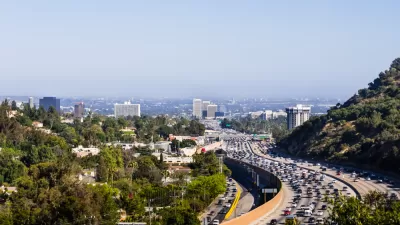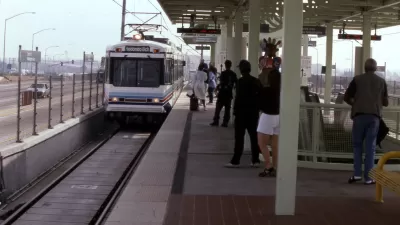The editorial board of the Los Angeles Times is unimpressed by a plan to build a monorail between the Westside and the San Fernando Valley in the city of Los Angeles.

The Los Angeles County Metropolitan Transportation Authority (Metro) recently updated its plan to build a rail transit connection across the Sepulveda Pass, a busy corridor currently served by the constantly congested Interstate 405, narrowing down the options to two, including a monorail.
The Los Angeles Times Editorial Board is unimpressed.
This is likely to be the biggest, most impactful transit project on the horizon for Los Angeles. It’s the most important missing link of the regional transit system, and done well, it could enable the next generation of Angelenos to work, play and travel without a car.
So why are we even considering a monorail?
The editorial lays the snark on thick—saying that monorail technology was cutting edge 50 years ago and comparing the renderings of the plan to Disneyland—but also tackles the proposal on its merits. While the project team behind the monorail proposal say the system would be cheaper and more efficient than a heavy rail alternative, the editorial board questions whether that promise can be delivered.
The editorial board also critiques a key element of the plan that is relevant to transit systems all over the county: running the new rail line in the middle of the freeway.
Haven’t we learned the fallacy of putting rail lines in the middle of a freeway? It is an unpleasant experience for passengers, who have to wait for their train on a noisy, exhaust-choked platform. And a monorail built over a 10-plus-lane freeway surrounded by buffers and surface streets would be hard for commuters to reach. The most successful transit lines drop people off close to their destinations.
A subway would be faster, more pleasant and more easily connected to other routes in the Metro system, according to the editorial.
FULL STORY: Editorial: Forget the monorail. L.A. needs a real transit line through the Sepulveda Pass

Planetizen Federal Action Tracker
A weekly monitor of how Trump’s orders and actions are impacting planners and planning in America.

Maui's Vacation Rental Debate Turns Ugly
Verbal attacks, misinformation campaigns and fistfights plague a high-stakes debate to convert thousands of vacation rentals into long-term housing.

Restaurant Patios Were a Pandemic Win — Why Were They so Hard to Keep?
Social distancing requirements and changes in travel patterns prompted cities to pilot new uses for street and sidewalk space. Then it got complicated.

In California Battle of Housing vs. Environment, Housing Just Won
A new state law significantly limits the power of CEQA, an environmental review law that served as a powerful tool for blocking new development.

Boulder Eliminates Parking Minimums Citywide
Officials estimate the cost of building a single underground parking space at up to $100,000.

Orange County, Florida Adopts Largest US “Sprawl Repair” Code
The ‘Orange Code’ seeks to rectify decades of sprawl-inducing, car-oriented development.
Urban Design for Planners 1: Software Tools
This six-course series explores essential urban design concepts using open source software and equips planners with the tools they need to participate fully in the urban design process.
Planning for Universal Design
Learn the tools for implementing Universal Design in planning regulations.
Heyer Gruel & Associates PA
JM Goldson LLC
Custer County Colorado
City of Camden Redevelopment Agency
City of Astoria
Transportation Research & Education Center (TREC) at Portland State University
Jefferson Parish Government
Camden Redevelopment Agency
City of Claremont




























